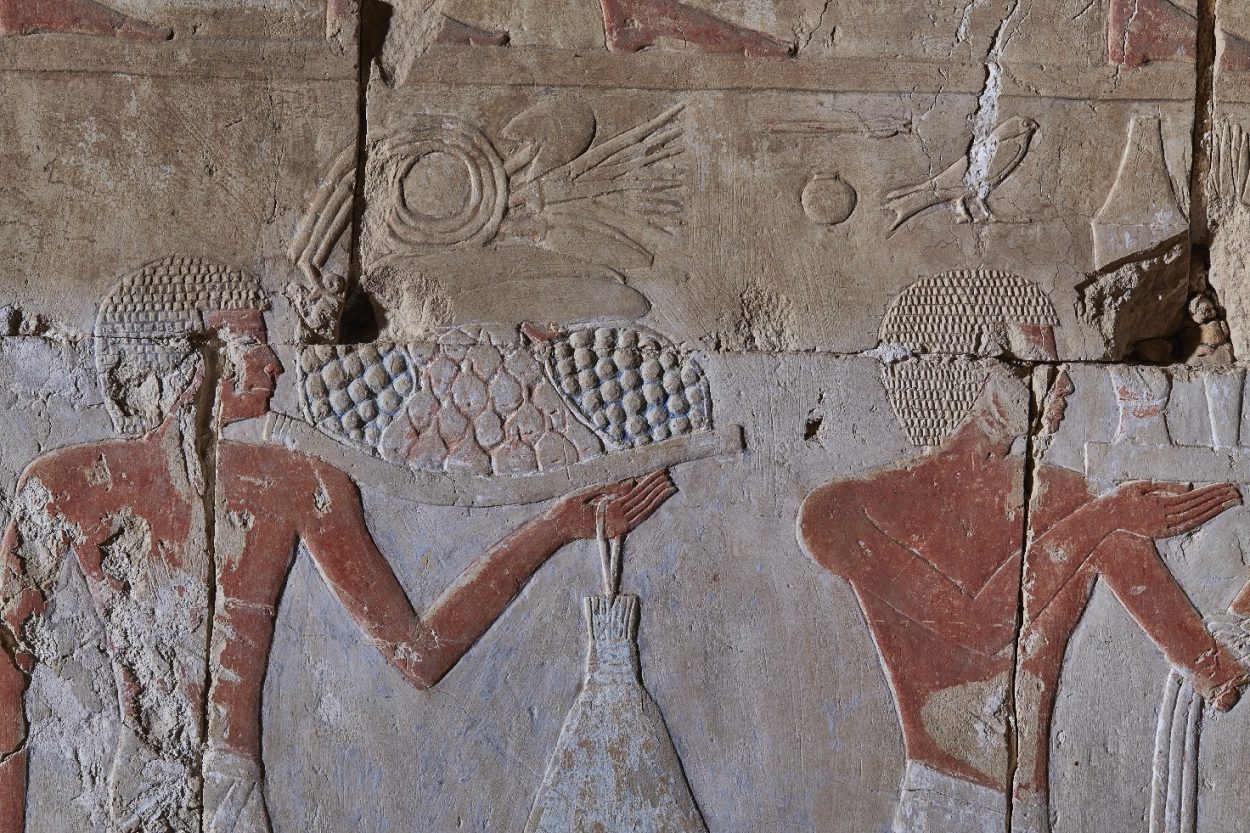Research documenting ancient Egyptian art at the Chapel of Hatshepsut has shed rare light on how the reliefs were made.
New light has been shed on how ancient Egyptian art was made by a pair of reliefs in the city of Thebes that contain traces of most of the steps in the art’s creation. Research was also able to identify which artists made which parts of the relief, where apprentices trained, and more.
Together, this provides a unique snapshot, frozen in time, of how this particular piece was produced and offers new insight into how ancient Egyptian art was made.
The discovery was made at the Temple of Hatshepsut, dedicated to the female pharaoh of the same name who ruled from 1473 – 1458 BC. In the largest room of the temple, known as the Chapel of Hatshepsut, are mirrored reliefs of a procession bringing offerings to the pharaoh.

For nearly a decade, researchers worked to fully document these massive reliefs; each of which is nearly 13 metres long and features 100 figures of offering bearers, along with the enthroned Hatshepsut and the list of her offering menu. In the process of documentation, Dr Anastasiia Stupko-Lubczynska, from the University of Warsaw, discovered traces of most of the steps of the relief making process in the art. Her work is published in the journal
Antiquity.
“The method was to render the wall surfaces at 1:1 scale on plastic-film sheets attached directly to the walls. These were then scanned and processed as vector graphics,” said Dr Stupko-Lubczynska, “I couldn’t stop thinking our documentation team was replicating the actions of those who created these images 3,500 years ago. Like us, ancient sculptors sat on scaffolding, chatting and working together.”
Archaeologists had long known how ancient Egyptian art was made thanks to half-finished pieces preserving the process in action. However, as each step in production covered up the previous one, evidence from finished pieces is rare.
“The chapel’s soft limestone is a very promising material for study, as it preserves traces of various carving activities, from preparing the wall surface to the master sculptor’s final touches,” said Dr Stupko-Lubczynska.
The seven-step process, with traces of most of them preserved in the Chapel, is:
1. Smoothing the wall and plastering of defects in the stone and joints between blocks.
2. Division of the wall surface into sections and application of a square grid.
3. The preliminary sketch is drawn in red paint, copied from a pre-prepared drawing.
4. Correction of the sketch by a master artist, who also added details in black paint.
5. Any text to accompany the images was inscribed.
6. With all the outlines done, the sculptors started their work, following the black lines.
7. The finished relief surface was whitewashed and coloured.
However, as well as finding traces of how the images were made, Dr Stupko-Lubczynska wanted to also study who was behind the impressive artwork.
“By studying traces left in the stone by ancient chisels, it was possible to ‘grasp’ several intangible phenomena, which normally leave no evidence in the archaeological record,” she said.
This included identifying which parts of the image were made by apprentices, or people with less skill, and which were made by the masters of their craft. As in Renaissance workshops, it seems that those with lower experience worked on non-complex parts like torsos, arms and legs, whilst more experienced artists tackled the complex faces – and corrected the apprentices’ mistakes.
Both groups would work together on the wigs as they were extremely time-consuming. It also offered a chance for the more experienced artists to try and teach others; in one area, a master started the wigs and an apprentice attempted to finish them to the same standard.
“In one place, a master’s workmanship is so remarkably detailed I feel it was done in front of the sculptor(s) learning from him and seems to say “Look at this! Who can beat me?’,” said Dr Stupko-Lubczynska.
“It is generally believed that in ancient Egypt, artists were trained outside of ongoing architectural projects,” she continued, “but my research in the Chapel of Hatshepsut proves that teaching also took place as reliefs were being executed – ‘on the job training.” Although this did not always work out – the research also spotted one wig only half-finished because the apprentice never did his part.
Dr Stupko-Lubczynska had hoped that the detailed record of the art produced by this project could allow for the identification of the hand of individual artists. However, the artists were working to create a homogenous work that matched ancient Egyptian style, masking any signs of individuality that could indicate a figure was made by master X or apprentice Y.
Nevertheless, it was possible to identify that a different crew worked on each of the mirrored reliefs, producing slight differences between them. For instance, a jug on the south wall is shown as a clay container on a rope, while on the north wall it is a metal container.
There were also parts where these crews had to deviate from standard practice. Some of the hieroglyphic inscriptions near the wigs, for example, appear to have been added later in the process than usual. This means that sculptors began their work before all the outlines of those inscriptions had been placed in paint, perhaps because the scribes had no access to that part of the wall as it was occupied by the sculptors practising wig carving.
Together, these reliefs offer not just a rare glimpse of how ancient Egyptian art was produced, but what life was like for the artists. How people with differing experiences had different roles and responsibilities, how crews divided up the work, how masters facilitated on-the-job training, and how those being trained would make mistakes, which had to be fixed. As such, these 2D reliefs provide a 3D snapshot of ancient Egyptians at work. Find out more
Header Image Credit : Antiquity





